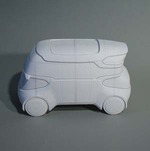MCOR’s Matrix 300, the 3D printer that prints in plain paper, was recently used by design students from London’s Royal College of Art to produce a vehicle design, shown above. The MCOR Matrix is unique among 3D printers due to its use of paper as a print material, resulting in extremely inexpensive (and recyclable) media. The MCOR might visually appear to be dark grey with orange highlights, but inside it’s quite green.
Student Robert Hagenstrom printed a representation of a 3m-long four-seat vehicle with an elevated seating position. From TCTMagazine:
Robert’s concept managed to create a vehicle with a modular personal space inside, using only three metres of length. This was accomplished by putting two small direct drive electrical engines under the rear passenger seats, with batteries under the front seats, and having no explicit cargo space. Because all four seats are seldom in constant use, the vacant ones can be folded and used to store items on.
Here’s the interesting part: the car is larger than the Matrix 300’s build chamber. Thus, the designers had to print component parts and then fit them together. Apparently this was the first time the Royal College of Art attempted 3D print assembly on the Matrix 300, and it turned out well, according to Nick Grace, Manager at the Royal College of Art:
We were apprehensive about how well the component parts would fit together so were delighted when both the accuracy and the surface finish exceeded our expectations. We look forward to exploring this technology further; I think it has a great future.
We’re thrilled the environmentally-friendly MCOR device is making progress.
Via TCT Magazine


